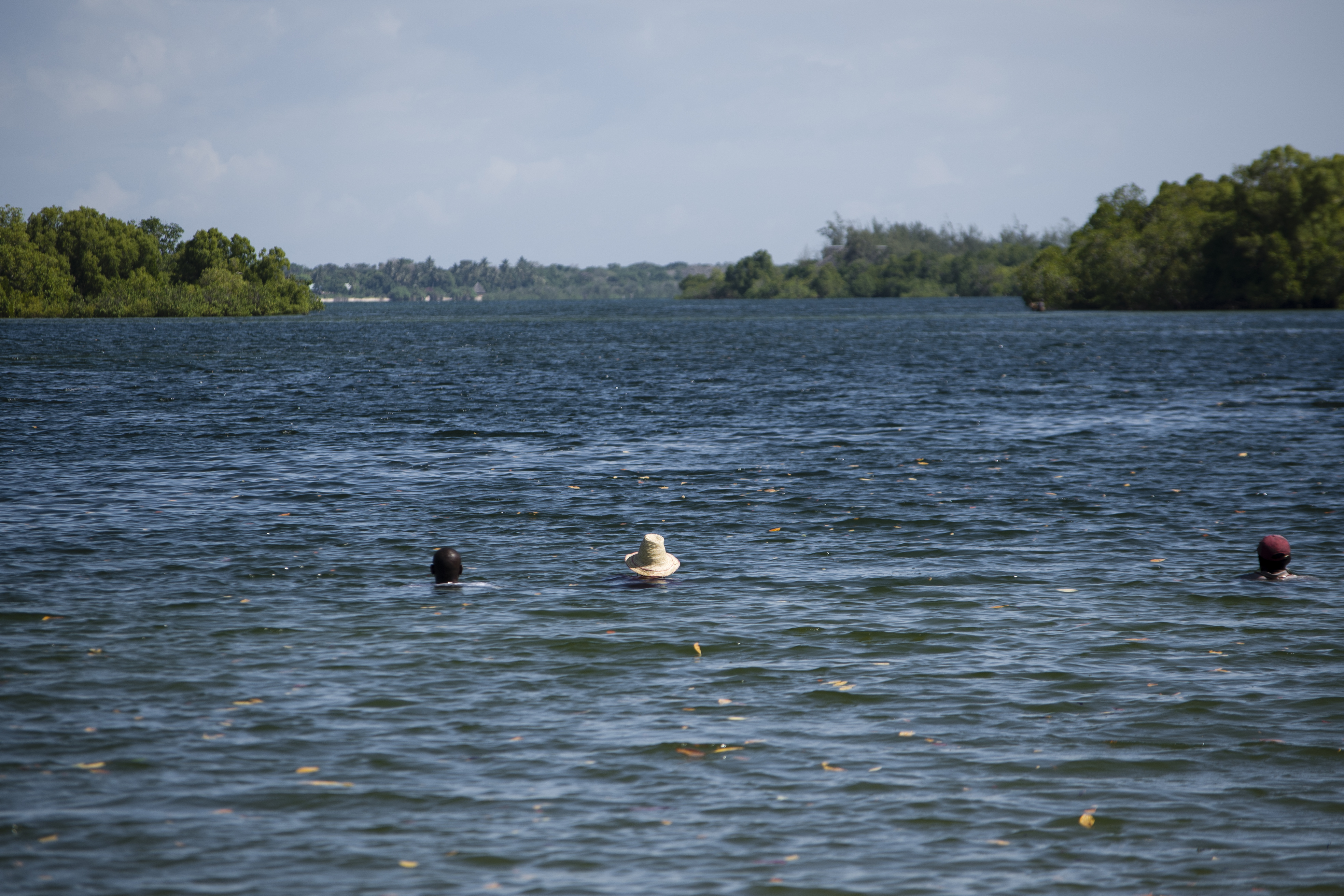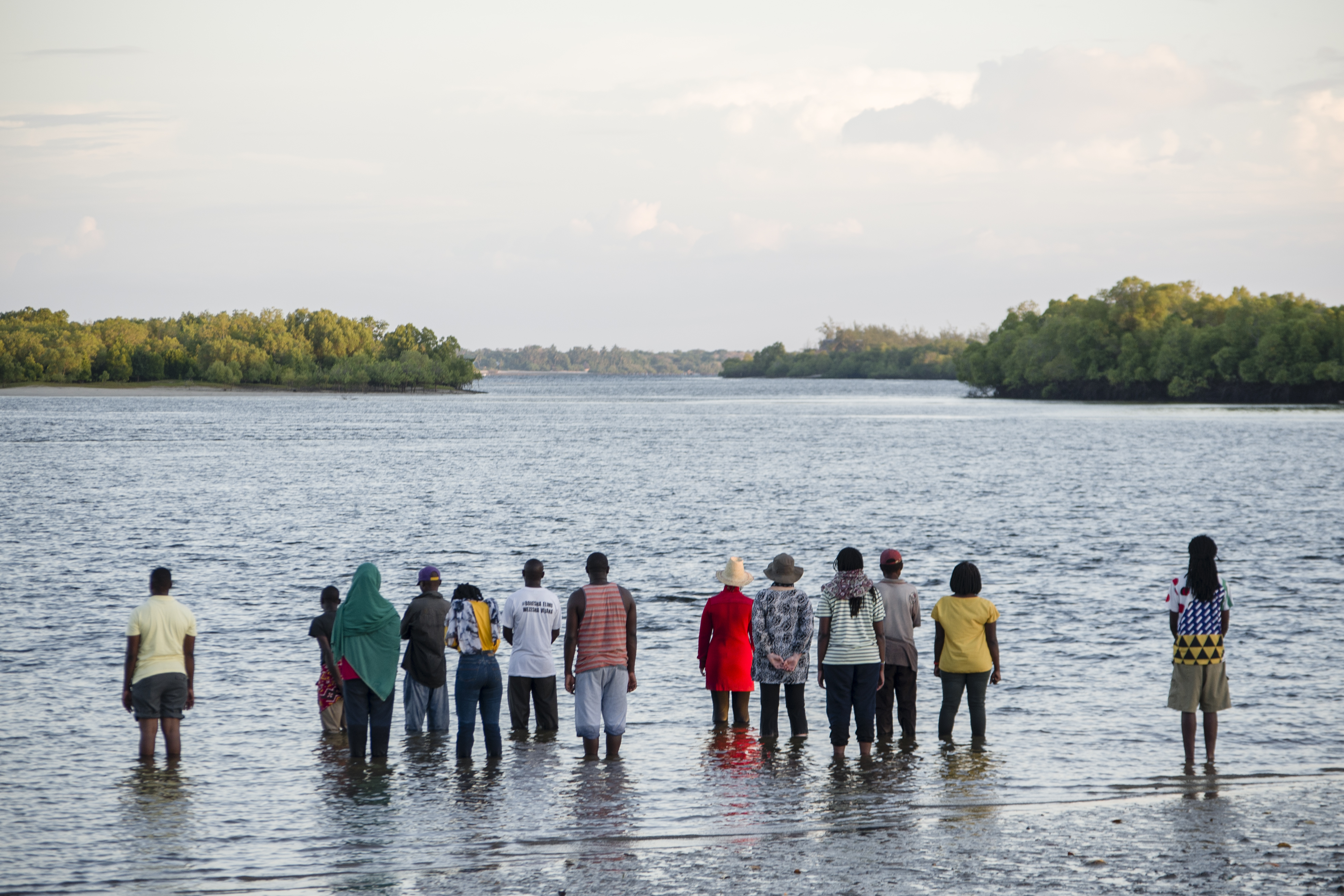High tides are deadly but one artist is using them to speak about climate change
The sound of the African drum tears through the crowd at the shores of the Bodo Inlet, 63 kilometres south of Kenya’s port city of Mombasa in the Indian Ocean, amidst ululation from the community members. Songs and traditional dances by a local arts group then follow.
Her feet deep in the water, 42-year-old American artist Sarah Cameron Sunde has been standing out in this part of the Indian Ocean since 8.10 am. The community performs this ritual which is expected to be done every 10 minutes past the hour for 12 hours to signal every lapse of an hour since she started her performance. Without leaving the water even for a minute, the artist takes on the challenge all day, in an act that combines time-based artistry and timely activism to call for solutions to the looming crisis posed by rising sea levels.
Sunde is the founder of the 36.5, a durational performance with the sea, an art project that was inspired by Hurricane Sandy that hit New York in October 201, killing 53 people and sending thousands homeless in its aftermath. The visual performance aims to make people think critically about what it will feel like to be submerged in water when the seas rise.
Sunde would stand in the ocean for a full tidal cycle, which lasts between 12 and 13 hours during which time the tide rises for 6 hours and later falls for another 6 hours. On this particular day, Sunde will be in the water until 8.16 pm, where the water will rise to her shoulders then fall back to her ankles again.
Scientists have attributed rising sea levels to global warming that results in the melting of glaciers and the expansion of sea water.

Sarah Cameron Sunde in the ocean during the high tide.
Photo courtesy 36.5 media team.
Sunde staged her first performance at the Bass Harbour in Maine on 15th August 2013.
Donned in a red pull neck sweater that would be her signature costume for all her performances to signal the dangers posed by the sea level rise, Sunde stood in the water along the rocky coastline from 11:04 am to 11:52pm, for a total of 12 hours 48 minutes in Maine.
Since then, she has staged performances in beaches in San Francisco, The Netherlands, Brazil, Mexico, and the Bay of Bengal.
At Bodo inlet, she marked the African leg of her performance. Just like all her performances; it was streamed live on her instagram page and timelapsed into a 12-minute video that will be exhibited in museums and public galleries.
The performance was showcased at the Kenya Cultural Centre in Nairobi, the Fort Jesus Museum in Mombasa and Bodo village.
The dangers posed by rising sea levels are a growing reality to the community in Bodo.
41-year-old Mohamed Mwangolo, a fisherman from Bodo, has seen too well the effects of sea level rise on their low-lying village.
“At first we thought that the phenomenon was being caused by erosion of the soil.” Mwangolo says.
Their turning point came in 2012 after an abnormal tide hit their beach leaving them at the mercy of the ocean water that had encroached their village.

Sarah Cameron Sunde and some of the residents of Bodo during the high tide.
Photo courtesy 36.5 media team.
In a quest to prevent such an occurrence again, Mwangolo and his fellow fishermen sought advice from local environment activists and formed Mwabofu, a local movement that started replanting degraded mangroves trees.
Mangrove trees which absorb four to five times more carbon compared to terrestrial trees have been fronted as an effective buffer in the war against climate change.
Mwangolo, who stood in the ocean for four hours alongside Sunde and later spearheaded an activity that saw 700 mangrove tree seedlings replanted, says the experience made him think of their village being engulfed in water and he hopes to push for behavioral change among members of his community who are still cutting down mangrove trees.
Bodo is not the only village reeling from the effects of rising sea levels. At the Fort Jesus museum where Sunde’s performances were exhibited, the museum board was forced to build a seawall to protect the heritage site that was eroding into the sea due to rising sea levels.
Further up north in Kipini, approximately 280 kilometers away, rising sea levels are being blamed for the increased salinity of Kenya’s longest river, Tana, putting the livelihoods of farming communities downstream at risk.
Without climate action, The Kenyan Ministry of environment forestry and natural resources predicts up to a meter rise in sea level along the 1420 kilometre coastline in the coming years. This is likely to contribute to a loss of $472.8 million in the agricultural sector, which is one of the major economic drivers of the region.
Amidst a target to limit the increase in temperatures to below 2 degrees by 2030, a November 2019 report by the University of Oregon has stated seas will continue to rise long after countries have achieved their commitments to the Paris Agreement.
Earlier this month, United States President Donald Trump led the country’s formal withdrawal from the Paris Climate Change agreement much to the chagrin of anti-climate change activists.
Even though Sunde believes that a work of art should not be politicized, the withdrawal is bad news for her as an American citizen.
“Every country should take responsibility for causing climate change” Sunde says.
Notes to Ping: In my opinion Sarah’s craft is more like a challenge rather than a performance because she stands still no talking, no eating, no bending . The only thing she takes is drinking water which is brought to her inside the ocean by a member of her crew.
The community performers add artistic value to the challenge and the performing ritual is done to signal every lapse of an hour since Sarah went into the water.
Sarah starts all most of her performances when the water is on her ankles. For six hours the tide rises to her face and for the next six hours the water will fall to her ankles then she can leave after the completion of the full tidal cycle.
The bodo inlet is actually in the Indian ocean.
You can read more about her project here >



